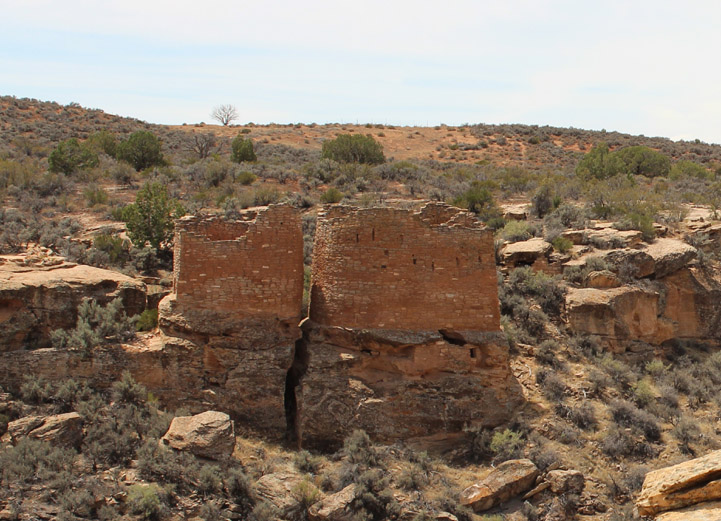Some people criticize an engineer’s tendency to let their technical perspective intrude into every aspect of their life outside the office. Most of us do it to some extent, but it isn’t necessarily a bad thing. This issue was raised this summer as I asked my family to hike an extra half mile in the desert sun to see an ancient reservoir. It was 105 degrees, and we already had five or six miles under our belts that afternoon. It doesn’t take much imagination to hear my 10-year-old daughter’s voice asking, “Really, Dad?” with the customary eye-roll. As luck would have it, the Prehistoric Mesa Verde Reservoirs had a plaque designating them as a “National Historic Civil Engineering Landmark” by the American Society of Civil Engineers. To be clear, this did not help one bit with my daughter’s complaints about bringing my engineering proclivities on vacation with me. This did, however, open the door to a number of observations about engineering and building things to last.
Observation 1: Straightforward Designs Are Timeless
The reservoirs in question were built in the year 750. No one involved had a computer, a license, or a college degree. Despite these “limitations” of the era, the reservoirs are thought to have been in service for 430 years. In our modern practice of engineering, I am accustomed to replacing buildings that have been in service for 50 or 60 years. The reservoir is a simple design: a large earthen depression with rock walls. It has a series of channels cut into the hills to gather water to itself. Given its longevity, it must have been effective. It met its end only when the settlements of the Ancestral Pueblo people (AKA Anasazi) that it served were mysteriously abandoned around the year 1300. Archeologists think that irrigation of this kind provided a harvest of up to 40 bushels of corn per acre. This compares to 15 bushels per acre with non-irrigated “dry farming” techniques. This simple engineering marvel probably made the difference between life and death in lean years, so it had to be reliable.
Observation 2: Water Is Not a Building’s Friend
 The small communities that were served by the reservoir are now part of Mesa Verde National Park. Many of the buildings were built under an overhanging cliff and are still largely intact. This is particularly remarkable because the builders lacked concrete or lime mortars for their stonework. The mortar is primarily mud. Despite this seemingly fatal limitation, the buildings stand relatively intact 700 years after they were abandoned. Parts of wood beams are still present in some of these buildings, too. Other buildings that were built on top of the cliff, with no shelter, are largely collapsed. The lesson is clear: water and the elements are not your building’s friends. This is something for the engineer to remember the next time a waterproofing and flashing detail is debated in a meeting. Protection from weather makes all the difference.
The small communities that were served by the reservoir are now part of Mesa Verde National Park. Many of the buildings were built under an overhanging cliff and are still largely intact. This is particularly remarkable because the builders lacked concrete or lime mortars for their stonework. The mortar is primarily mud. Despite this seemingly fatal limitation, the buildings stand relatively intact 700 years after they were abandoned. Parts of wood beams are still present in some of these buildings, too. Other buildings that were built on top of the cliff, with no shelter, are largely collapsed. The lesson is clear: water and the elements are not your building’s friends. This is something for the engineer to remember the next time a waterproofing and flashing detail is debated in a meeting. Protection from weather makes all the difference.
Observation 3: Nothing Can Compensate for a Weak Foundation
 One of the buildings has an interesting flaw. It was constructed over a crack in the underlying rock. The builders probably didn’t think it was important, but the weight of the building appears to have exacerbated it. The crack reflected itself through the building’s wall and is there to this day. Perhaps they should have aligned the building differently. Another community, a few hours’ drive away, had a different solution to this issue. They built an independent structure on each half of a crack in the supporting rock. As the rock has split, perhaps made worse by the weight of the buildings, the two structures have done just fine.
One of the buildings has an interesting flaw. It was constructed over a crack in the underlying rock. The builders probably didn’t think it was important, but the weight of the building appears to have exacerbated it. The crack reflected itself through the building’s wall and is there to this day. Perhaps they should have aligned the building differently. Another community, a few hours’ drive away, had a different solution to this issue. They built an independent structure on each half of a crack in the supporting rock. As the rock has split, perhaps made worse by the weight of the buildings, the two structures have done just fine.
What struck me most about each of these observations about building longevity is the simplicity of achieving them. None requires advanced analysis. Each is about making good decisions at the beginning of the design process and not cutting corners along the way. Most of my designs have been constructed in the Pacific Northwest and Alaska. Hiding them from the weather is not possible, but simple steps to keep the structures dry and structurally sound are.



